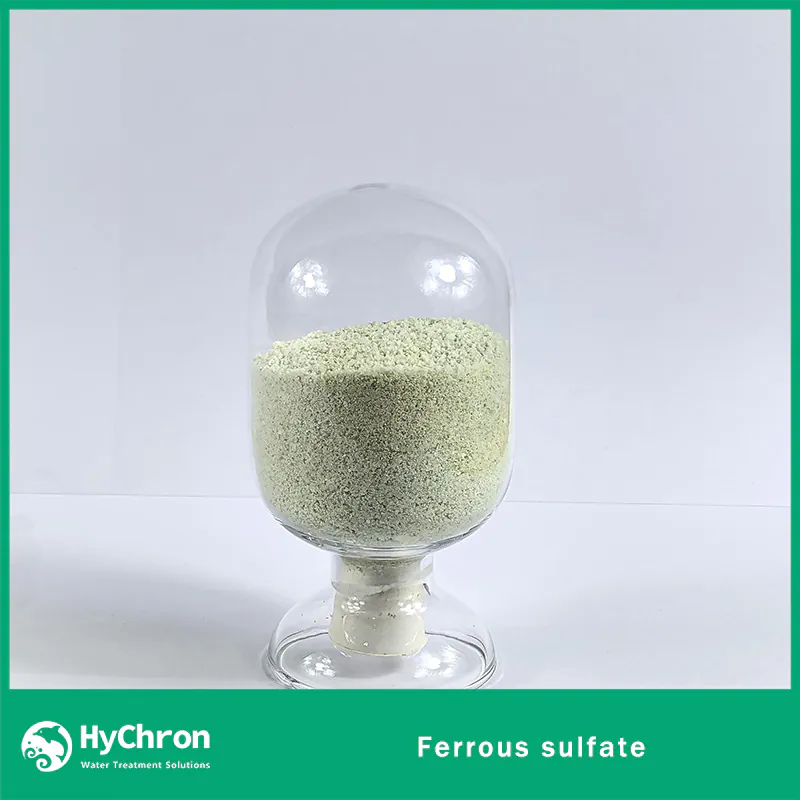Ferrous sulfate (FeSO₄) is a cost-effective coagulant widely used in industrial and municipal wastewater treatment. It excels in flocculation, reduction, and decolorization. This guide explains its features, working principles, optimal conditions, and practical uses to help businesses improve efficiency and cut costs.

Three Core Functions of Ferrous Sulfate
① Flocculation & Sedimentation Ferrous sulfate releases ferrous ions (Fe²⁺) that react with suspended particles and colloids, forming dense, fast-settling flocs.
✅ Best paired with: Polyacrylamide (PAM) for enhanced flocculation. Ideal for pretreatment stages.
② Reduction: Removing Heavy Metals & Oxidants Fe²⁺ acts as a reducing agent, neutralizing toxic oxidants like hexavalent chromium (Cr⁶⁺), permanganate, and nitrite.
✅ Works for:
- Industrial wastewater with heavy metals (Cr, Cu, Ni).
- Wastewater containing oxidants (e.g., permanganate).
③ Decolorization: Ideal for Dye Wastewater Ferrous sulfate breaks down color-causing compounds in wastewater from textile, dyeing, and paper industries.
✅ Boost effect: Combine with PAM for better color removal.
Types of Ferrous Sulfate
| Type | Appearance | Features | Applications |
| Heptahydrate (Green Vitriol) | Green crystals | High water content, dissolves easily | General wastewater treatment |
| Anhydrous | White powder | Low moisture, stable storage | Facilities needing dry, stable storage |
✅ Heptahydrate: Most common due to low cost.
✅ Anhydrous: Preferred for humidity-sensitive environments.
Optimal Usage Conditions
- pH Range: ✅ Best: pH 8–9 (alkaline). ❌ Avoid: pH <6 (weak flocculation) or pH >9 (higher dosage needed).
- Dosing Method: Dilute before adding to improve reaction efficiency.
Ferrous Sulfate vs. Other Coagulants
| Coagulant | pH Range | Key Uses | Pros | Cons |
| Ferrous Sulfate | 8–9 | Flocculation, reduction, decolorization | Low cost, fast settling, good decolorization | Poor performance in acidic pH; absorbs moisture |
| PAC | 5–8 | Turbidity/organic removal | Broad pH suitability (municipal) | Weak phosphorus removal |
| PFS | 4–11 | Phosphorus removal, flocculation | Wide pH range, strong phosphorus removal | Higher cost |
| Aluminum Sulfate | 5–8 | Drinking water treatment | Safe for potable water | Poor performance in cold water |
✅ Usage Tips:
- Municipal wastewater: PAC or ferrous sulfate.
- Phosphorus removal: PFS.
- Dye wastewater: Ferrous sulfate + PAM.
Economic & Environmental Benefits
- Cost-Effective: Cheaper than PAC/PFS.
- Less Sludge: Reduces sludge volume, lowering disposal costs.
- Eco-Friendly: Minimizes chemical residues compared to organic coagulants.
When to Choose Ferrous Sulfate?
✅ Pick Ferrous Sulfate If:
- Budget-friendly solutions are needed.
- Wastewater is alkaline (pH 8–9).
- Heavy metal removal or decolorization is required.
By matching ferrous sulfate to specific needs, businesses can improve treatment efficiency, reduce costs, and meet environmental standards.
Need help optimizing your wastewater treatment? Contact us for expert guidance!
